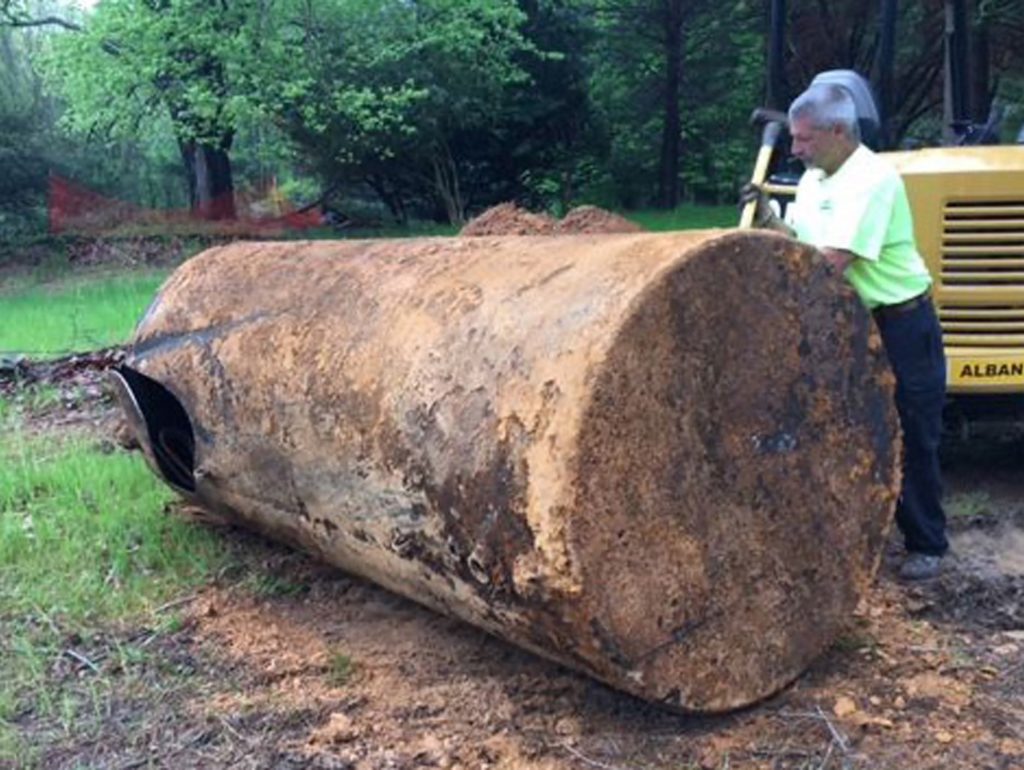
A leaking tank or fuel feed is more than just expensive; it’s an environmental nightmare that will cost you…big time. If you have a leak, the extent of the cleanup is typically controlled by one of the regulatory agencies, requiring you to pay for highly specialized fuel spill cleanup specialists.
The average oil tank has a life expectancy is about 15–20 years. After this timeframe, tanks begin to deteriorate and cause issues such as sludge formation, corrosion, rust, and, most alarming of all, leaks and contamination.
Signs of a Leaking Oil Tank
The signs of a leaky heating oil tank can range from subtle or unmistakable. Indoor oil tanks are not always in plain sight inside your building and outdoor tanks are even less noticeable – receiving less attention. A small leak could be affecting the tank for days, weeks, or even longer before you notice it.
The Environmental Protection Agency (SPCC Rule) advises you to test and inspect your tanks on a regular schedule. While you want to inspect your oil tank for leakage, there are a few other indicators that your tank needs to be serviced or replaced. A fuel sample test performed by a professional will determine if there is water present in the tank. Because water is heavier than fuel, it will sink to the bottom of the tank and because water often has contaminants in it, that can result in the build-up of bacteria, rust, corrosion sludge and even condensation in the tank.
You can count on ACE in the event of a leak or spill, 24/7. Our residential and commercial above and under ground tank experts can offer you the guidance and prompt service required to mitigate major liabilities (info@aceenvironmental.net, 410.354.8030 or toll free at 866.750.4223).
Think your tank needs looking at? Here are some important indicators something may be wrong:
Odor
It’s normal to have an odor of oil after the tank is filled, but any odor lasting more than an hour or two after the tank has been filled may indicate a bigger problem. Oil fumes aren’t just unpleasant, they can be hazardous to your health.
Puddles of Fuel
There should never be oil around the tank. If you spot a reddish, viscous puddle around it, you most likely have a significant leak.
Fuel Along the Seams
If you spot droplets of fuel along the seams and joints of the tank, you have a small problem that, if left unaddressed, could potentially have a serious environmental impact.
Unaccounted for Increases in Fuel Usage
Small blips are normal, of course, as your oil usage adjusts to colder weather conditions. If you find a significant increase in fuel usage without a clear reason, however, you may be dealing with a leaking oil tank.
Oil Stains
Your leak may not be enough to cause a standing pool of fuel, but oil stains on the floor or ground around the tank indicate an ongoing issue that needs attention. Outdoor tanks may experience dead or dying foliage or grass around and under the tank.
Oil Tank Inspection: A Stitch in Time
The idea of inspecting your oil tank, regardless of its age, is to stop a small problem before it becomes a huge problem. Some leaks can be repaired, but if these leaks are the sign of an aging, deteriorating oil tank, you will need to replace it immediately.
Inspect your oil tank, checking for:
- Stability: Make sure all the legs of the tank are level and secure.
- Broken gauges: Regularly make sure gauges are functioning correctly.
- Vent pipe clogs: Make sure the vent pipes are free of debris.
- Fuel feed leaks: Inspect the fuel feed lines for signs of leaking, especially around the valves.
- Signs of a leak: Even a tiny pinhole can cause massive headaches. Check for odors, wet spots, and stains.
- Weather Exposure: If the tank is outside, make sure it is capped tightly to prevent water from then cover it to keep water from infiltrating the tank.
- Malfunctioning vent alarm: If your oil tank has a vent alarm, make sure it sounds when the tank is filled.
- Rust: Any oil tank that has signs of rust is in danger of failing. It will also pollute your oil which could lead to many other problems., which is very bad for your heating system
Service or Replace?
Having a professional inspect your heating oil tank is the best way to fully understand your options. Depending on the age of the tank and the issue you’re experiencing, a pro may be able to repair the tank or its elements rather than replacing the entire tank.
On the other hand, replacing the tank may be your best option if it is leaking excessively, shows signs of deterioration, or has reached the end of its lifespan.
ACE is There, Day or Night
ACE Environmental is equipped and experienced in handling oil spills and tank removals. We understand and appreciate the way a leak or spill can spiral out of control, so you can call on us anytime, day or night – and we’ll get it done right for you.
Call ACE immediately if your oil tank inspection has uncovered signs of a leak, no matter how big or small, before you’re left out in the cold this winter.
(info@aceenvironmental.net, 410.354.8030 or toll free at 866.750.4223).
